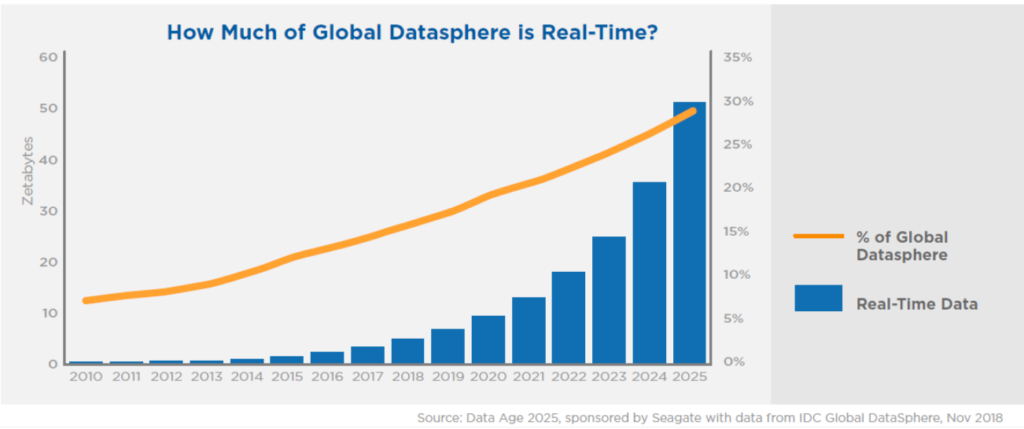
“Technology changes, economic laws do not.” This is one of the most important concepts highlighted in 1994 by Carl Shapiro and Hal R. Varian in their book Information Rules. This simple idea describes the importance of the real effectiveness of a technology in order to be widely adopted. This is one of the reasons for the success of data virtualization, as it delivers efficiencies and tangible economical values: time savings (and therefore speed).
Now is the Time
Speed is extremely important today because of the general technological impact of digital transformation. At the heart of this process is not only technology but the way data is used and consumed for business purposes. In fact, companies are collecting data at a speed, and in volumes, never before seen.
According to IDC (Global DataSphere Research – 2018), around 30% of data will be real-time in 2025. This is close to 600% growth since today and it is based on the same volume of data generated today. This represents a huge change in business scenarios, as it means higher customer expectations and much more complex IT infrastructures. As IDC pointed out, “Digital transformation is not related to the evolution of devices, but it is about the integration of data into everything that we do. Always tracking, always on, and always learning” (see Fig.1 ).

In addition, today we are facing a critical situation due to the COVID-19 pandemic. As McKinsey highlighted in a recent report, “the need for speed has never been greater” (“Ready, set, go: Reinventing the organization for speed in the post-COVID-19 era”). Companies have to change more rapidly than ever before to ensure fast decision making, new production lines, and new customer services. In fewer words: new ways of working.
The Business Value of Data Virtualization is Time (and Speed)
Data architecture that was designed 10 or 15 years ago is not able to answer to the requirements of new complex IT infrastructures such as cloud services, artificial intelligence/machine learning (AI/ML) capabilities, the Internet of Things (IoT), and Mobile 5G applications. To address these requirements, companies need a different approach to ensure what matters the most: fast data delivery. The most efficient approach is not a physical approach to data integration, but a logical approach, which enables faster data delivery to data consumers, regardless of the physical location of the data sources. The result is the possibility to use data from different systems and sources as if they were stored in a single, virtual database. This is what data virtualization is all about.
In collaboration with the Department of Business Economics of the University of Roma Tre in Rome, Italy, Denodo has studied 170 data virtualization projects to analyze the business reasons and implications of adopting data virtualization. Not surprisingly, the main benefit achieved is time savings, which means speed. Speed enables faster data delivery which, in turn, means less time to make critical decisions in a competitive environment, as well as higher efficiencies due to faster project delivery. Critical decisions can be made in real or near-real time.
The most interesting results of this analysis are:
- Data virtualization creates business value in three main areas: revenue increase, cost savings, and risk mitigation.
- Data virtualization enables up to 10 times faster data delivery. Data is delivered where it is needed, when it is needed, and in the right format for the right users. This enables a much more agile and flexible organization.
- Data virtualization delivered benefits in more than one business area in 35% of the analyzed cases, so it can be implemented for different purposes or use cases, and this maximizes ROI.
- Data virtualization is being implemented in many different industries (25) and countries (22) worldwide.
- Data virtualization can be implemented in organizations of any size, from small-medium (47%) to large, global enterprises (53%).
From a business point of view, here are some of the most interesting projects in the study, identified by business area.
Revenue Increase
Faster new product/service development
- During the COVID-19 crisis, a leading U.S. bank was overwhelmed by new loan requests, which were coming in 20 times more frequently than normal. The capacity to speed up the integration of multiple data sources enabled the bank to implement a new lending and reporting process in just two days.
Customized offers and solutions
- A large insurance company implemented a new 360° view of its customers, to provide faster personalized offers and a faster claims process.
Real-time, competitive pricing
- A global retailer implemented a competitive pricing analysis process using multiple data sources, to enable faster product and pricing strategy decisions, including promotions and special discounts.
Up-selling/cross-selling opportunities
- A global mobile operator (GMO) achieved more than 65% faster call center operations, with detailed customer information that enabled agents to offer specific services during call-center interactions.
Cost Savings & Operational efficiencies
IT cost savings
- A U.S. government agency achieved more than 95% savings, thanks to the implementation of a new data platform based on data virtualization.
- A leading global investment bank achieved 500% ROI in automating and speeding up self-service BI processes, while assuring required data governance and compliance.
Faster Time-to-Develop & Operations
- A global high-tech manufacturer achieved up to 90% time savings in new data services deployment worldwide, which delivered millions of dollars in overall yearly savings.
Risk Mitigation (M&A, Data Governance, and Compliance)
- An EMEA regional bank, adopted new agile data platform based on data virtualization to ensure agility and speed for its M&A operations, which lead the bank to integrate different systems and processes.
- A leading global fashion group adopted data virtualization to ensure GDPR compliance for more than 20 million customers’ data, stored in multiple systems and countries, therefore protecting brand reputation and shareholder value.
These projects are just a few examples of why innovative technologies such as data virtualization are adopted: real economic advantages delivered by time savings and speed.
